
Minikube is still under active development, and features may change at any time. Release notes are available here.
Free file archiver utility, free Rar files software download. PeaZip is free file archiver utility, based on Open Source technologies of 7-Zip, p7zip, FreeArc, PAQ,.
Distribution
Minikube is distributed in binary form for Linux, OSX, and Windows systems for the v1.1.1 release. Please note that Windows support is currently experimental and may have issues. Binaries are available through GitHub or on Google Cloud Storage. The direct GCS links are:
Darwin/amd64
Linux/amd64
Windows/amd64
Installation
OSX
Feel free to leave off sudo cp minikube /usr/local/bin/ && rm minikube if you would like to add minikube to your path manually.
Or you can install via homebrew with brew cask install minikube.
Linux
Feel free to leave off sudo cp minikube /usr/local/bin/ && rm minikube if you would like to add minikube to your path manually.
Debian Package (.deb) [Experimental]
Download the minikube_1.1.1.deb file, and install it using sudo dpkg -i minikube_1.1.1.deb
RPM Package (.rpm) [Experimental]
Download the minikube-1.1.1.rpm file, and install it using sudo rpm -i minikube-1.1.1.rpm
Windows [Experimental]
Download the minikube-windows-amd64.exe file, rename it to minikube.exe and add it to your path.
Windows Installer [Experimental]
Download the minikube-installer.exe file, and execute the installer. This will automatically add minikube.exe to your path with an uninstaller available as well.
Usage
Documentation is available here.
Checksums
Minikube consists of a binary executable and a VM image in ISO format. To verify the contents of your distribution, you can compare sha256 hashes with these values:
ISO
Prepare Windows 10 ISO file
After you have downloaded the Windows 10 ISO, you need prepare it, this is especially important for Windows 7 users..
After obtaining the .iso file you can use the built in Disc Image burning tool or Microsoft .iso to USB/DVD tool to create a bootable DVD or USB (requires a blank DVD or USB flash stick of at least 4 GB).
After downloading the .ISO file, right click it and click Burn disc image
Insert a blank DVD
Click Burn
Iso To Exe
Windows 8/8.1 users can mount the .ISO file and start the upgrade automatically. Learn more here
Important:
If you are creating a bootable USB thumb drive, make sure the thumb drive is first formatted as FAT32.
Connect the thumb drive
Open Computer
Linux Iso Download
Right click thumbdrive
Click Format
Make sure FAT32 is selected as the file system.
For UEFI based systems
If your computer is UEFI based, these are normally systems that come pre-loaded with Windows 8 or later, you will need to prepare the ISO file for such a configuration or you will receive an error message during setup. The thumbdrive needs to be formatted as FAT32 and use the GPT partitioning scheme. To do this, you need to use Rufus, a small tool you can download for free.
Rufus - credit: Pete Batard/Akeo
Why Did The Iso Download As Exercises
After you have installed Rufus:
- Launch it
- Select ISO Image
- Point to the Windows 10 ISO file
- Check off Create a bootable disk using
- Select GPT partitioning for EUFI firmware as the Partition scheme
- Choose FAT32 NOT NTFS as the File system
- Make sure your USB thumbdrive in the Device list box
- Click Start
- Close when complete
Why Did The Iso Download As Exercise
You can launch setup from the setup media by doing the following:
Press Windows key + R
Type: x:setup.exe
x represents the drive where the Windows 10 files are stored.
Windows 10 Iso Download
Open Computer and look for the drive name.